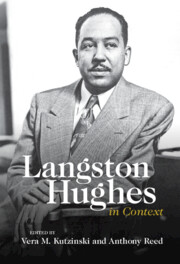Book contents
- Langston Hughes in Context
- Langston Hughes in Context
- Copyright page
- Contents
- Contributors
- Abbreviations
- Introduction
- Part I Singing America
- Chapter 1 Langston Hughes, Chicago, and Modernism
- Chapter 2 Jazz, Performance, and Modernist Embodiment in Langston Hughes’s Early Writing
- Chapter 3 His Ways with White Folks
- Chapter 4 Love at a Distance in Selected Letters by Langston and Carrie Hughes
- Chapter 5 Langston Hughes’s 1930s Short Fiction
- Chapter 6 Langston Hughes and Simple
- Chapter 7 Langston Hughes’s Famous Books, Ebony Magazine, and the Politics of Civil Rights in Biographies for the Young
- Chapter 8 Rural Black Masculinity and the Blues in Not without Laughter
- Chapter 9 From the Sublime to the Grotesque
- Chapter 10 Coalitional Aesthetics
- Chapter 11 Langston Hughes’s Translingual Poetics and Pedagogy
- Part II The Global Langston Hughes
- Part III Afterlives
- Index
Chapter 9 - From the Sublime to the Grotesque
Red Langston Reconsidered
from Part I - Singing America
Published online by Cambridge University Press: 10 November 2022
- Langston Hughes in Context
- Langston Hughes in Context
- Copyright page
- Contents
- Contributors
- Abbreviations
- Introduction
- Part I Singing America
- Chapter 1 Langston Hughes, Chicago, and Modernism
- Chapter 2 Jazz, Performance, and Modernist Embodiment in Langston Hughes’s Early Writing
- Chapter 3 His Ways with White Folks
- Chapter 4 Love at a Distance in Selected Letters by Langston and Carrie Hughes
- Chapter 5 Langston Hughes’s 1930s Short Fiction
- Chapter 6 Langston Hughes and Simple
- Chapter 7 Langston Hughes’s Famous Books, Ebony Magazine, and the Politics of Civil Rights in Biographies for the Young
- Chapter 8 Rural Black Masculinity and the Blues in Not without Laughter
- Chapter 9 From the Sublime to the Grotesque
- Chapter 10 Coalitional Aesthetics
- Chapter 11 Langston Hughes’s Translingual Poetics and Pedagogy
- Part II The Global Langston Hughes
- Part III Afterlives
- Index
Summary
This chapter argues that Langston Hughes’s 1930s red poetry posits a proletarian-internationalist notion of authenticity, one that attempts to close the cognitive gap between lived reality, on the one hand, and the latter’s spatial, temporal, and structural determinations, on the other. The chapter maintains that two dominant poetics articulate this authenticity, namely, the Communist Sublime and the Antifascist Grotesque. Although each poetics corresponds to a specific set of concerns of the contemporaneous Communist-led Left, both endeavor to unite a fragmented global proletariat using various thematic and formal strategies. Viewed as heuristics allowing us to link Hughes’s radical poetry to the context of Great Depression–era Communism, the Communist Sublime and the Antifascist Grotesque refute the misconception that authenticity was an exclusive feature of the poet’s Black-vernacular work. They also unveil the hopes and fears that defined Hughes’s literary imagination as the possibility of proletarian revolution gave way to war and Fascism.
- Type
- Chapter
- Information
- Langston Hughes in Context , pp. 94 - 103Publisher: Cambridge University PressPrint publication year: 2022

